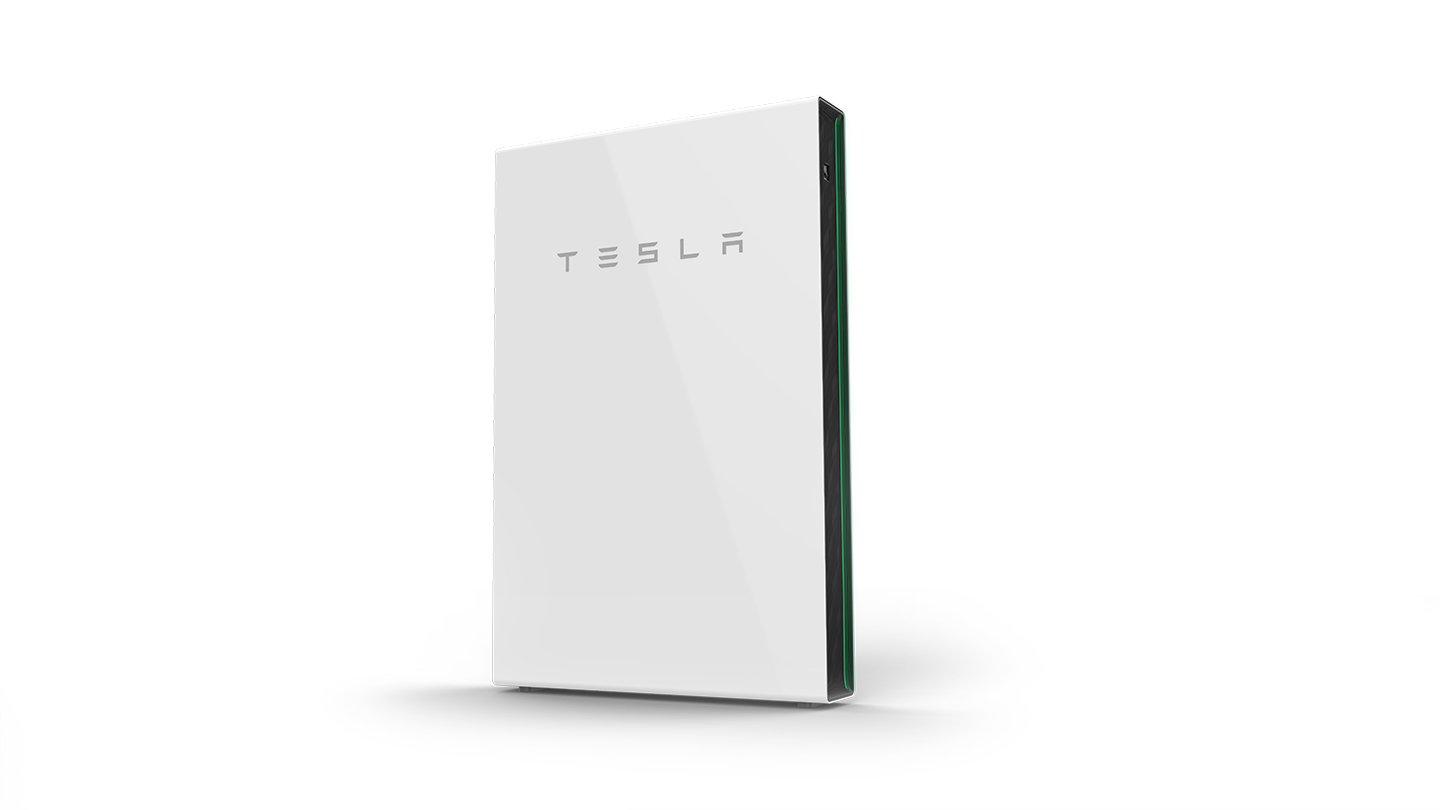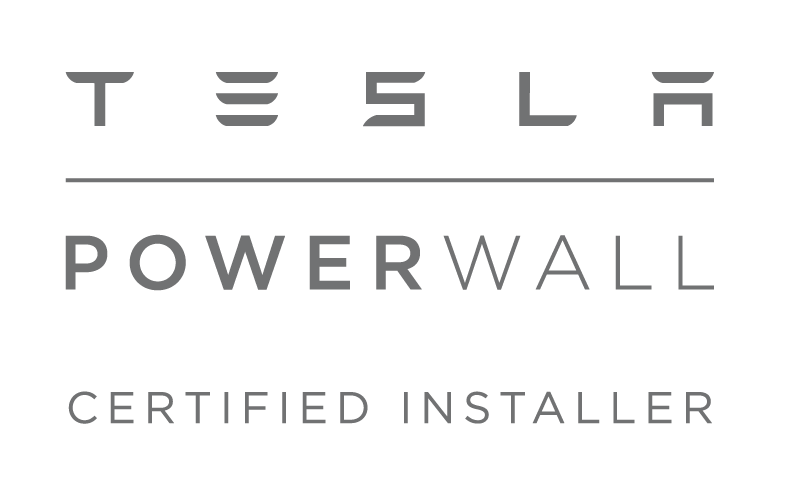
As Western Canada continues its shift to clean energy sources like solar power, curious customers (and future SkyFire Energy customers), are starting to ask more questions about solar plus storage. After all, if the majority of solar power occurs during the day, and most people are at work during the day, people want to maximize their investment and actually use the solar power their panels are creating. Enter the Tesla Powerwall 2.
One of Tesla’s future-focused business decisions was its announcement of the Powerwall in 2015. Knowing that solar energy was becoming more common and that people around the world would be seeking greater energy independence, Tesla developed a technology that could turn every home into its own independent energy producer. The Powerwall, which was eventually further developed into the Powerwall 2 being installed today, was presented as an energy storage solution that would utilize mobile phone technology and advanced battery cells to allow homeowners to maximize solar energy usage.
Read on to find out what a Powerwall is, how it helps homeowners store and fully utilize their solar energy, and what it would take for you to install one in your home.
Nuts and Volts
Basically, the Powerwall is a rechargeable lithium-ion battery system with built-in communication technology. It also contains an inverter, which converts the DC battery voltage to the 240 volts AC that your home consumes. By connecting with a special, unique-to-Tesla, electrical panel called the Backup Gateway, the Powerwall acts as a hub between your home, your solar panels, your Tesla electric vehicle (if you have one), and the electrical grid. That hub, which is fully controllable and viewable from a mobile phone app, pulls solar energy from a solar panel array and stores it in the lithium-ion batteries for later use.
Depending on the time of day, solar panel production, and the power your house is using, the Powerwall is able to prioritize the energy being produced by the solar panels for use. When there is stored solar energy waiting in the Powerwall, it chooses to use that before it uses power from the electrical grid.
The same principle applies to a Tesla electric vehicle. If your Tesla EV is plugged into its charger (which is also connected to the Powerwall), the Powerwall knows to send its stored solar energy from the batteries to the electric vehicle before it draws electricity from the grid.
Peak Performance
For the clean energy nerds out there, the Powerwall 2 is capable of electrical performance that places it clearly at the top of the home energy storage class. Indeed, much like Apple’s pioneering dominance over smartphone technology as the first company to create a coherent, customer-ready product, Tesla created the entire industry and demand for home energy storage with the Powerwall.
Energy Sage has a great article we used as a key source for this article. Their breakdown of the key technology at play and the performance metrics boiled down to four key elements: size (i.e. power and capacity), chemistry, depth of discharge, and roundtrip efficiency. Don’t worry, we’ll keep things as accessible as possible while we break down exactly what makes the Powerwall such a useful and complete solution.
Power and Capacity
Power = maximum electrical output at one time (kilowatts or kW)
Capacity = maximum electricity in a battery at full charge (kilowatt-hours or kWh)
As any installer can tell you, the Powerwall 2 weighs every ounce of its 264 pounds. It is a hefty piece of technology, and that is because each unit is designed to hold enough power to charge an average house’s essential energy needs for a day or so. More specifically, that means lights, plugs, a fridge, and a couple of phones and computers, as a ballpark example.
When talking about the capabilities of the Powerwall, Energy Sage had a great metaphor for electricity. If you were to picture electricity as water in a pipe, the power is the size of the pipe, i.e. how much water can flow at one time, and the capacity is the total amount of water available to flow through the pipe.
The peak continuous power of the Tesla Powerwall (5 kW) never changes, just like a water pipe — that is determined by the design and engineering. The capacity, however, is constantly fluctuating and going up and down as your home and vehicle use power, and the solar panels (and sometimes the grid) top up the battery and return energy to it for later use.
Each Powerwall is rated for 13.5 kWh of usable capacity. A typical estimate for an entire average-sized home (with loads like air conditioning, pool heaters, and pumps, electric vehicle charging) is 28 kWh of power in a day, so Tesla’s typical recommendation to go mostly off-grid is a setup of two Powerwalls. That said, a smaller home or a family with more modest electrical needs could account for most of their energy needs with a single Powerwall.
Chemistry
 For those uninitiated, a typical battery such as what is in your vehicle, mobile phone, or TV remote, is a container with two or more chemicals inside, with an electrical imbalance built into it due to the nature of the chemicals. Two terminals (represented by a + and a -) allows electricity to flow when they are connected together, and that chemical electrical imbalance is what needs to be constantly restored when the battery drains.
For those uninitiated, a typical battery such as what is in your vehicle, mobile phone, or TV remote, is a container with two or more chemicals inside, with an electrical imbalance built into it due to the nature of the chemicals. Two terminals (represented by a + and a -) allows electricity to flow when they are connected together, and that chemical electrical imbalance is what needs to be constantly restored when the battery drains.
There are many different combinations of chemicals and designs for batteries, for many different purposes. Some chemicals, such as a car battery, create fumes while the battery is charging or discharging, so they can only be used in certain applications for safety reasons. Other chemicals are safe to use in any location, but they cannot be recharged so that the negative ions want to flow through an electrical circuit.
Tesla’s lithium-ion batteries (more specifically, lithium-nickel-manganese-cobalt) are among the safest and most efficient batteries available on the market. Lithium-ion batteries do not create fumes during use, and they are guaranteed to retain 70% of their full capacity after 5000 full charge cycles.
You may be asking: why does Tesla expect their product to become less useful over time, as in have less battery capacity? The reality of battery technology is that all batteries degrade over time since no process in all of nature is a 100% closed loop. During the process of charging and discharging a battery, the conducting material and the chemicals themselves lose their vitality over time. Luckily, with the emergence of battery technology hand-in-glove with solar, more and more efficient battery styles and technologies are being researched and developed every day.
Depth of Discharge
We’re getting into the technical weeds a bit here, so stick with us. A battery’s depth of discharge is how much energy a manufacturer recommends a battery can use without reducing the length of the battery’s life. A less robust battery with a lower depth of discharge shouldn’t drop below a certain capacity without being charged, or the battery itself will be damaged and not last as long. So if a 10 kWh battery is rated at 80% depth of discharge, it shouldn’t drop below 2 kWh of capacity.
Since Tesla has used the most advanced battery technology available, Powerwalls are rated at 100% depth of discharge. That is, they could have every usable watt of electricity drained from them and not be damaged or affected in the long term at all.
Roundtrip Efficiency
This measure of electrical efficiency has to do with the charge and discharge cycles. In the process of converting live electricity (i.e. from the grid or a solar array) into electrical potential energy (i.e. inside a battery), there are some losses. That is, you don’t get every watt of energy back from your battery that you put in. It’s just an electrical fact.
Since Powerwalls are top of the line tech, their efficiency from live electricity, to battery storage, back to live electricity, is 90%. So technically, your solar panels will have to put in more than 13.5 kWh worth of energy to fully charge one Powerwall. Luckily, it’s coming for free from the sun!
Time-Based Control
Tesla’s revolutionary energy management framework means the Powerwall app is capable of refined management that helps owners maximize their off-grid capabilities, while also saving money in jurisdictions that use time-of-use electrical billing. While Western Canadian jurisdictions do not currently bill this way, in many places like Ontario and California, electricity costs more during times of peak demand (generally the afternoon and early evening) than it does during the day.
Powerwalls can account for this through the phone app. If owners enter their peak and off-peak times, the Powerwall will send its (free) stored solar energy to your home during peak times when energy costs more, and allow your home to pull from the grid only when energy is cheaper or when it absolutely must top up energy from the grid. It’s all managed quickly and simply through the phone app and can be managed at any time, even when away from home.
 Tesla and SkyFire
Tesla and SkyFire
SkyFire Energy is Western Canada’s trusted solar energy provider. We are also one of the few contractors Certified by Tesla to install Powerwalls for our customers. Our team of solar specialists and installers can meet you to discuss your needs, provide a detailed estimate, and complete a clean, professional-looking installation at any time. Simply visit our home page and find contacts for our team in your area.
Learn why Tyson and Chris chose the Tesla Powerwall:
More information on Tesla Powerwall:
https://www.tesla.com/en_CA/powerwall
https://cleantechnica.com/2018/10/12/tesla-powerwall-price-features-new-coming/
https://omar.shahine.com/blog/2019/9/1/tesla-powerwall
https://www.youtube.com/watch?v=Eh6gqPI51pU
Article was written by James Nason – Electrical Apprentice and Writer for SkyFire Energy

